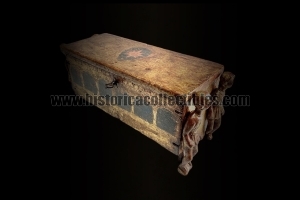Chest, Proconsul of the Guild of Judges and Notaries of Florence, 1350-1420
Table chest, dating back to between 1350 and 1420, which belonged to a Proconsul, the highest representative of the Guild of Arts and Crafts of Florence and the third most important figure in the city after the Gonfalonier of Justice and the Signoria.
The Chest Box, rectangular in shape and made entirely of wood, engraved, gilded and painted, bears on its lid the emblem which confers its membership to the Guild of Judges and Notaries of Florence (eight-pointed gold star in blue field). Sculptures are applied to its corners, configured in the shape and clothes* of the "pages", in positions designed to support him: they had to metaphorically represent the 4 characters whom the Proconsul was obliged by statute to have following him on every official move, under penalty of a pecuniary fine if he were found alone, i.e.: two Nuncios assigned to his person and to carrying letters, a Flag Bearer assigned to carrying the Banner of Judges and Notaries, and finally a Naccherino dedicated to playing a drum with his hands called "Catanket".
Furthermore, since the Chest Box already had an arched base in its structure designed to support it from the support surface, the four figures took on a purely symbolic meaning which could be interpreted as "supporting" the importance and "weight" figurative of the documents or money contained within it: in fact, the Proconsul was a magistrate who presided over the Guild of Judges and Notaries as well as being Head of the Court of Mercatanzia or Mercanzia of all the Arts and Crafts in the medieval Florentine Republic, and what was contained in this Chest Box, it must have had considerable legal importance for all those situations and vicissitudes in which his figure was affected.
The Chest Box is also enriched by six paintings with lowered arches in light blue, both on the front and rear façade, which recall the architectural forms of the wall niches of some Florentine Basilicas (Basilica of S. Maria Novella, Santa Croce etc. etc.) or which recall the large windows and doors present in the large public and private buildings of medieval Florence. It is also worth noting, on the front panel and the one behind, the presence of two burin engravings composed of a Cross above the World and flanked by the two letters in Gothic character "F" and "M" which mean (Fraternitas Misericordiae). Therefore, since this is the oldest set used as an emblem by the Confraternity of Mercy, whose foundation dates back to the 13th century, it is likely that this Proconsul served, with his work, one of the branches present in Florence and was also its brother.
It is for this last reason, a fascinating and suggestive hypothesis to evaluate that this chest was designed and created by interpreting the practical and idealistic dictates considered in the book of Exodus (25.10-22; 37.1-9) for the construction of the Ark of the Covenant designed to safeguard the Tablets of the Law that God delivered, according to the Christian religion, to Moses: in fact it too was rectangular in shape, made of wood completely covered in gold and had 2 poles which would have allowed 4 people to "transport" it.
Furthermore, the Corporations developed alongside the religious brotherhoods to which they were closely linked.
Extraordinary historical artefact that belonged to one of the highest positions in the service of the Florentine Republic in the Gothic-Renaissance period.
* Young people often wore the *cottardita, a garment, already widespread in the fourteenth century, tight to the waist and ending in an open flounce that reached just below the hips.
History:
One of the first cities to adopt corporations and where they had a fundamental importance for not only the economic but also political life of the citizens, was Florence. The Arts of Florence began to be established as guilds of arts and crafts between the 12th and 13th centuries and were divided into Major Arts and Minor Arts. This division was adopted as a model generally in all the cities of the peninsula.
The seven corporations that took the name of Arti Maggiori were established between the second half of the 12th century and the first half of the 13th century, progressively detaching themselves from the "mother" corporation of Calimala; first the Art of the Exchange was born, then that of the Judges and Notaries and of the Wool, until each of them acquired its own specific physiognomy, established by the rules contained in their statutes, which regulated their functioning and representative bodies. In 1266 the main headquarters of the Major Arts was still Calimala and in that year it was decided that these associations should be organized in an even more stable way, each with its own banner, under which to gather the people in arms if necessary. The members of these corporations found themselves managing and administering large interests and managed to create commercial and financial relationships in many parts of the world; their economic primacy led them by the end of the thirteenth century to the leadership of the Florentine Republic, to whose greatness and splendor they contributed significantly by launching the whole series of public works which still today bear witness to the wealth and power of the city.

